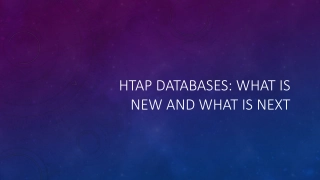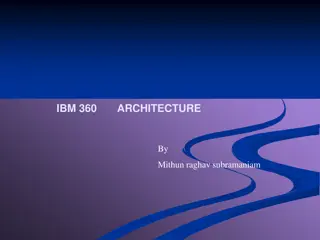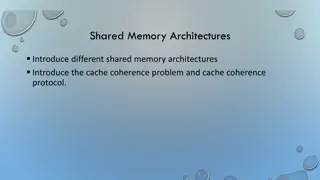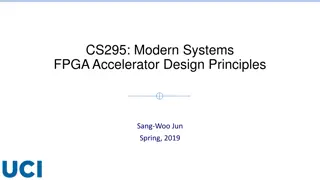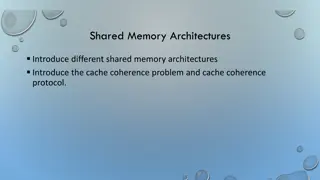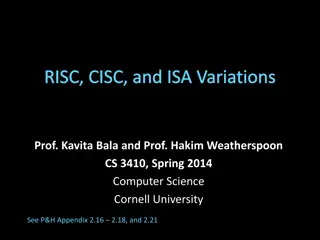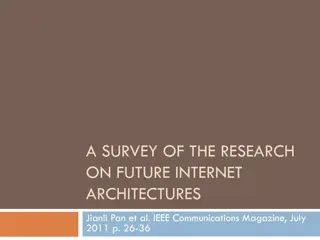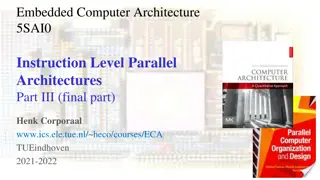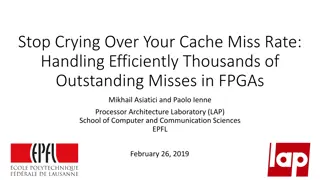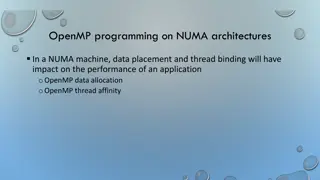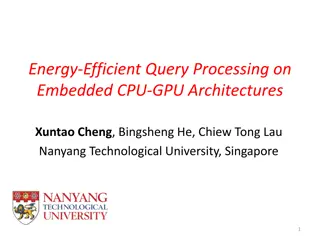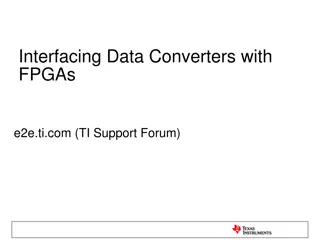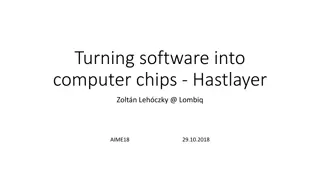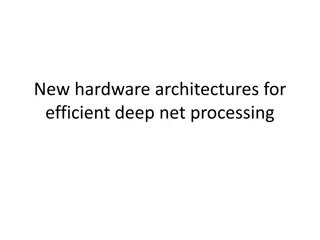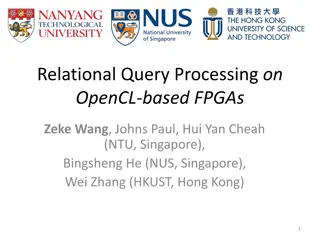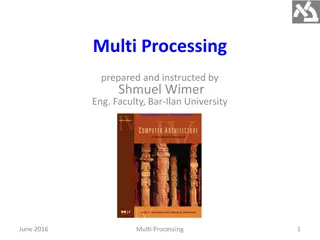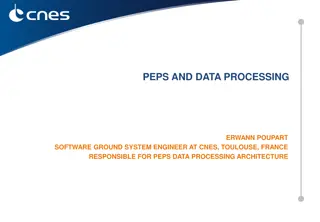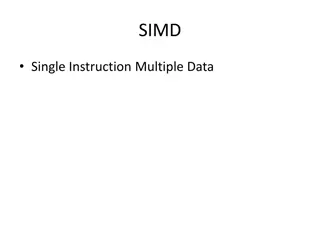Data Processing with FPGAs on Modern Architectures
Datacenters face challenges managing increasing data streams, seeking efficient solutions like FPGAs. Explore FPGA architecture, benefits, HLS tools, and their role in addressing datacenter DRAM issues.
Uploaded on Mar 03, 2025 | 0 Views
Download Presentation

Please find below an Image/Link to download the presentation.
The content on the website is provided AS IS for your information and personal use only. It may not be sold, licensed, or shared on other websites without obtaining consent from the author.If you encounter any issues during the download, it is possible that the publisher has removed the file from their server.
You are allowed to download the files provided on this website for personal or commercial use, subject to the condition that they are used lawfully. All files are the property of their respective owners.
The content on the website is provided AS IS for your information and personal use only. It may not be sold, licensed, or shared on other websites without obtaining consent from the author.
E N D
Presentation Transcript
EPL646: Advanced Topics in Databases Data Processing with FPGAs on Modern Architectures Wenqi Jiang, Dario Korolija, and Gustavo Alonso. 2023. Data Processing with FPGAs on Modern Architectures. In Companion of the 2023 International Conference on Management of Data (SIGMOD '23). Association for Computing Machinery, New York, NY, USA, 77 82. https://doi.org/10.1145/3555041.3589410 By Markos Othonos: mothon01@ucy.ac.cy 1 https://www2.cs.ucy.ac.cy/courses/EPL646
Introduction Datacenters need to manage the constantly increasing streams of data (more than 400Gbps*). CPUs yield relatively low performance and energy efficiency compared to other solutions. IOs still have a heavy impact on performance. They care about MICROSECOND scale delays! 2 *https://community.hpe.com/t5/around-the-storage-block/data-center-transformation-the-road-to-400gbps-and-beyond/ba-p/7152221
Contents What are FPGAs? Datacenter configuration issues. Farview Approximate Nearest Neighbor search. Vectie Recommendation Systems. Microrec ACCL 3 *https://community.hpe.com/t5/around-the-storage-block/data-center-transformation-the-road-to-400gbps-and-beyond/ba-p/7152221
FPGA architecture Composed of three main type of blocks. CLBs have look up tables (ROMs) to return the result of a logical function. SBs direct the data flow accordingly and form the final design. IOBs, allow outside communication. * 4 *https://www.quora.com/What-is-FPGA-How-does-that-work
FPGA benefits FPGAs have many IOBs, allowing parallel access to many channels. (Intel stratix 10 has up to 144 transceivers!) Line rate data processing! Power efficient! Reconfigurable. Potential to fabricate designs to ASICs, increasing performance and energy efficiency! C/C++ programmability support! 5
FPGA HLS Tools * Hardware description languages have a steep learning curve (VHDL, verilog). Implementing a single accumulate operation needs more than 20 lines! High level synthesis tools can help reduce this number to less than 5 lines. (of C/C++ code). Less than 23 lines of C/C++ lines of code needed to make a matrix multiplication operation! multiply and 6 *https://www.youtube.com/watch?v=FDt_qxCmOkc
Datacenter DRAMs Datacenter vendors load as much data as possible to the DRAMs to minimize latency. Solutions such as loading all the data to exacerbates data movement Remember, DRAM capacity is relatively expensive in cost and power. DRAMs 7
Datacenter configurations * Datacenters may employ strategies such as compute and storage disaggregation. Cost-efficient scalability. (i.e we may need more storage nodes than compute nodes) Potential bottleneck is the network too much data to move. Smart data movement is required! 8 *https://www.diva-portal.org/smash/get/diva2:1292615/FULLTEXT01.pdf
Farview Targets to reduce network traffic in datacenters with compute and storage disaggregation. Partially disaggregate memory from memory nodes. Manage each memory pool using an FPGA. 9
Farview Leverage FPGAs line rate processing, to offload a query s operators, while extracting data from the DRAMs. Less data needs to travel through the network, alleviating the bottleneck concerns. Each smart disaggregated memory module can serve multiple computer nodes, due to the usage of RDMA. * 10 *Korolija, D., Koutsoukos, D., Keeton, K., Taranov, K., Milojivci'c, D., & Alonso, G. (2021). Farview: Disaggregated Memory with Operator Off-loading for Database Engines. ArXiv, abs/2106.07102.
ANNS Approximated Nearest Neighbor Search retrieve relevant data from large vector data collections. Used in multiple search engines or recommendation systems (or even large language models). Deals with scalability issues of NNS ( i.e. growing datasets high dimensional vectors). Quantizing vectors, reduces their dimensionality - more efficient storage. Trades-off accuracy for performance and resource efficiency. Since quantized vectors take less space, they can be stored in main memory, for minimal time spent on IOs. CPUs are bad at dequantization. (and GPUs have bad latency response) 11
Vectie Vectie comes with a computer node which is responsible for coordinating Smart Disaggregated Memory Nodes. Each SDMN is equipped with an FPGA, capable of dequantizing vector codes very fast. Essentially, the ANNS task is broken down and handled from multiple SDMNs. * 12 * Wenqi Jiang, Dario Korolija, and Gustavo Alonso. 2023. Data Processing with FPGAs on Modern Architectures. In Companion of the 2023 International Conference on Management of Data (SIGMOD '23). Association for Computing Machinery, New York, NY, USA, 77 82. https://doi.org/10.1145/3555041.3589410
Recommendation Systems They have both memory and computation bound processes. Multiple embedding tables are looked at total memory consumption may reach up to hundreds of GBs! Additionally, memory accesses may not be sequential! There is need of very high bandwidth! * 13 * Jiang, W., He, Z., Zhang, S., Preu er, T.B., Zeng, K., Feng, L., Zhang, J., Liu, T., Li, Y., Zhou, J., Zhang, C., & Alonso, G. (2021). MicroRec: Efficient Recommendation Inference by Hardware and Data Structure Solutions. Conference on Machine Learning and Systems.
Microrec Utilizes the numerous channels available to an FPGA. HBM is used if supported by FPGA board. Alleviates the memory access bottleneck. Reduces memory accesses, by applying cartesian products of tables. A single memory access may retrieve multiple embedding vectors. If applied on smaller embedding tables only, not much data will be redundant. * 14 * Jiang, W., He, Z., Zhang, S., Preu er, T.B., Zeng, K., Feng, L., Zhang, J., Liu, T., Li, Y., Zhou, J., Zhang, C., & Alonso, G. (2021). MicroRec: Efficient Recommendation Inference by Hardware and Data Structure Solutions. Conference on Machine Learning and Systems.
ACCL FPGAs are very fast at processing. What about a cluster? ACCL is a collective communication library like OpenMPI. ACCL manages to gain higher throughput, and lower latency than a host-driven MPI, when messages are large. Meaning that better scalability is offered through the usage of FPGAs. 15
Cluster with FPGAs * ETHZ HACC public computing available for academic research, with open-source tools. Support for networking. 16 * Wenqi Jiang, Dario Korolija, and Gustavo Alonso. 2023. Data Processing with FPGAs on Modern Architectures. In Companion of the 2023 International Conference on Management of Data (SIGMOD '23). Association for Computing Machinery, New York, NY, USA, 77 82. https://doi.org/10.1145/3555041.3589410
Conclusion FPGAs are versatile and efficient in terms of performance and energy usage. HLS enable easier development of FPGA designs. FPGAs can be used: To alleviate network bottleneck concerns in datacenters with compute and storage disaggregation. To alleviate memory bandwidth bottleneck concerns of memory intensive workloads. To perform DNN computations fast and efficiently. As a cluster to perform tasks more efficiently - if large message sizes.
EXTRA SLIDES https://www.cs.ucy.ac.cy/courses/EPL646 19
FPGA Blocks A B C D Out 0 0 0 0 1 0 0 0 1 1 0 0 1 0 0 0 0 1 1 1 .. .. .. .. .. .. .. .. .. .. 1 1 1 1 0
Why NOT GPUs? Good throughput. Good energy efficiency. Very bad latency. In the best case: more than 600 times the latency of a CPU! S. R. Agrawal, V. Pistol, J. Pang, J. Tran, D. Tarjan, and A. R. Lebeck, Rhythm: Harnessing Data Parallel Hardware for Server Workloads, in Proceedings of the 19th International Conference on Architectural Support for Programming Languages and Operating Systems, 2014.
Compute Node Compute Node Compute Node Storage Nodes RDMA Network SmartNIC - FPGA Disaggregated Memory Node Disaggregated Memory Node Dram Dram Dram Dram https://www.cs.ucy.ac.cy/courses/EPL646 22


